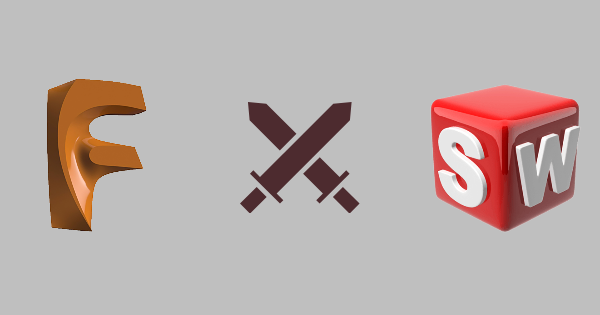The Fusion 360 vs SolidWorks battle is a common thought.
SolidWorks was created by Dassault Systèmes, and it was the first fully commercialized 3D CAD modelling software. It has since remained a popular software option in the engineering, design, and manufacturing industry.
As more developers and software companies recognized the importance of 3D modelling, new software options such as Autodesk’s Fusion 360 were introduced.
Both Fusion 360 and SolidWorks are used by similar professionals, including architects, civil engineers, animators, designers, and manufacturers. They’re closely related software packages that do the same thing at their core.
This similarity pitches professionals and users on either side, claiming one of the two is better than the other. This article discusses the top 7 differences between Fusion 360 and SolidWorks.
1.Part Modelling
Fusion 360 is the newer software of the pair, and it offers an updated part modelling process where it uses a multi-component part system. This allows individual assembly components to be built and assembled in a single file. It’s an efficient modelling method for small scale assembly projects because designers don’t have to sort through multiple files when building an assembly.
Comparatively, SolidWorks is primarily an assembly-driven software that offers an optional multi-component system. This means each assembly part in SolidWorks has a different file, which are then assembled in a separate file. This is an effective method for large scale projects where individual parts will be used in multiple assemblies.
Fusion 360’s part modelling method also allows team members to cross-reference parts in an assembly and build off them. In contrast, SolidWorks’ assembly-driven method is highly useful when you need to document each part’s model.
2. License And Subscription Costs
SolidWorks has no free version and offers a tiered subscription payment model for its licensing options, including standard, professional, and premium. Its standard license costs $3995 and an annual maintenance fee of $1,295 for a total of $5,290, while the professional license costs $5,490 and an annual maintenance fee of $1,495 for a total of $6,985. The premium license costs $7,995 and an annual maintenance fee of $1,995 for a total of $9,990.
Each of SolidWorks’ subscription packages offers varying simulation features, which are highly important to large-scale engineering and design teams. SolidWorks’ reputation for robust features and high-performance makes it well-priced, but it’s considered a premium software for freelancers and hobbyists at a price range of $5,290 and $9,990.
Fusion 360 offers competitive pricing with a $60 monthly subscription, $495 yearly subscription, and $990 for two years. It requires no licensing fees along with the subscription fees. It also offers a free trial period of a month and unlimited upgrades with the subscription.
Fusion 360’s free version is open to students for three years and unlimited for businesses with annual revenue less than $100,000. This pricing and free options of Fusion 360 makes it a more favourable buy for small business owners and hobbyists.
3. Array of Features
Fusion 360 features are abundant, but they’re regarded as generic compared to SolidWorks’ specific and detailed features. Fusion 360’s distinguishing feature on the paid version is Generative. Generative allows designers to define project objectives, generate and explore designs, optimize materials and design, and export CAD-ready files.
Features available on both the paid and free version of Fusion 360 are distributed into three design environments: model, patch, and sheet metal. The available features include animation, rendering, advanced analysis tools, surface modelling, mesh modelling, and sketching.
SolidWorks offers an array of features that are applicable in engineering and manufacturing designs. They’re offered cumulatively based on the subscription tier structure of the software. Available features on each license type include:
- Standard License: The standard license offers 3D modelling, assembly, weldments, plastic parts, sheet metal, mould design, Computer-Aided Manufacturing (CAM) standard. The only available simulation feature is static stress.
- Professional License: Additional features on professional license and subscription include photorealistic rendering, circuit works, cost estimation, part libraries, and the SolidWorks PDM standard. Additional simulation features in this package include frequency, thermal, drop test, and buckling.
- Premium License: Additional features on the premium license and subscription include pipe, duct, and wire routing, advanced surface flattening, environmental impact analysis, and structural analysis of parts and assembly. Additional simulation features in this package include large deformation, non-linear materials, and topology optimization.
4. Mechanical Design Application
This pair of software packages are primarily meant for 3D modelling and design. However, they differ in their application to core mechanical design, which requires advanced real-life simulations. Fusion 360 offers basic simulation features, including thermal analysis, buckling, and static stress analysis but lacks SolidWorks’ advanced features.
SolidWorks’ tiered license and subscription packages allows it to offer highly advanced simulation features as users pay more in the subscription order. SolidWorks’ standard license is closer to Fusion 360’s basic array of features. Users get additional features such as thermal testing, large deformations, and buckling on the professional and premium version.
Hence, for determining the application and responses of mechanical, design, and manufacturing parts, SolidWorks is the better option, while for basic checks, Fusion 360’s simulation features are sufficient.
5. Mesh Modelling And Manufacturing Application
Creating organic geometry and surfaces is effortless with Fusion 360’s mesh modelling option. This is achieved using its non-parametric design interface and sculpt feature. SolidWorks offers similar capabilities to Fusion 360’s surfacing features. Without the sculpt mode on SolidWorks, its mesh modelling process is time-consuming, and it does not produce the smooth geometry available on Fusion 360.
Fusion 360 also functions effectively as a CAM software. Its CAM features are compatible with multiple manufacturing processes such as 3D printing, CNC machining, and lathe machines. Fusion 360’s ability to switch seamlessly between parametric and non-parametric modelling also makes it a highly versatile 3D modelling software for manufacturing purposes.
SolidWorks is gradually transitioning to design-to-manufacture by integrating features for industrial designers and engineers. This allows it to support manufacturing needs, including 3D printing, moulding, and CNC machining. Due to a lack of optimization, as it transitions, some of these features aren’t yet fully ready for the manufacturing process, like Fusion 360
6. Platform Support And Cloud Sharing Functions
Fusion 360 is available for both Windows and Mac operating systems, while SolidWorks is exclusively for Windows systems. SolidWorks’ unavailability on Mac OS can be a problem while working with teams that use only Mac OS. Virtual machines such as Bootcamp can enable SolidWorks to run on Macs but not quite optimally.
Fusion 360 is a cloud-based software that requires no installation on your laptop device. It runs on an online interface called A360. Individual designers have a dedicated A360 account on which all their design files are stored and accessible from any device and location. Design teams can also collaborate and share designs among themselves with authorized access. Fusion 360 solves all issues around back up, and team collaboration but requires a reliable internet connection and involves a high dependence on Autodesk’s servers.
SolidWorks lacks the updated cloud-sharing abilities on Fusion 360. Design teams have two options to enjoy team collaboration. One is to store files on a combination of Product Data Management (PDM) software and servers with a floating license for every team member to access. The second is to store design files on a third-party cloud-based storage system such as Dropbox and Google Drive. This second process will impact software performance negatively.
7. User Interface

The distribution of features into model, patch, sheet metal environments in Fusion360 enables a clean user interface (UI). Its simplified UI facilitates an easier learning process due to easy access to design tools. SolidWorks helps designers to cope with its complex and robust UI with a full-programmable keyboard.
Designs and models are easier and faster to complete on the Fusion 360’s interface compared to SolidWorks. This is due to a higher level of flexibility and decluttered workflow process in Fusion 360. For example, pre-set construction geometries in Fusion 360 enable the simplified creation of all the basic shapes, including rectangles, circles, and squares.
The feature tree on Fusion 360 is longer than that of SolidWorks. Fusion 360 designers typically need a wider screen area such as a desktop PC or at least a 15.6 inches laptop screen. Otherwise, they struggle with scrolling through features after selecting a geometry in the workspace. SolidWorks can run properly on a 14-inch screen without a need to scroll through the features tree.
The summary of Fusion 360 vs. SolidWorks is in the table below:
| S/N | Fusion 360 | SolidWorks |
| 1 | It runs a multi-component part system. | It runs an assembly-driven model with an optional multi-component part system. |
| 2 | It uses both parametric and non-parametric design methods. | It uses parametric design but is gradually enabling non-parametric designs. |
| 3 | It offers subscription without licensing fees between $60 and $495. | It offers licensing and subscription fees between $5,290 and $9,990. |
| 4 | It is limited in simulation features which suffices for small-scale design projects but limited in mechanical design applications. | It has a robust array of simulation features that make it suitable for large- and small-scale mechanical design projects. |
| 5 | It is optimized for mesh modelling with its sculpt mode. | It uses its surfacing features which aren’t fully optimized. |
| 6 | It’s fully optimized for manufacturing processes such as 3D printing, CNC machining, and lathe machines. | It’s not fully optimized for design-to-manufacture because it’s in its transition process to full industrial application. |
| 7 | It’s offer dual support on Windows and Mac OS. | It’s exclusive for Windows OS. |
| 8 | It is an exclusive cloud-based software which allows full team collaboration and effective backup. | It must be installed on a local device and is not fully optimized for team collaboration. |
| 9 | It features a clean and simple UI that’s easy to learn. | It features a robust and complex interface that isn’t easy to learn. |
Takeaway
3D CAD modelling is synonymous with the SolidWorks software, but Fusion 360 brings many features, functions, and applications that make it a viable option. The first distinguishing factor between the two is part modelling, where Fusion 360 uses a modern multi-component part system compared to SolidWorks’ assembly-driven model.
Computer-Aided Design started with basic 2D CAD modelling. 3D CAD modelling was developed as a much-needed derivative and improvement on available 2D CAD modelling software packages. They were useful in showcasing and simulating real-life models.
Solid Works offers three different license and subscription packages, while Fusion 360 is subscription-based and offers a trial period and free version. SolidWorks is ahead of Fusion 360 in the array of features available and mechanical design application. Fusion 360 outshines SolidWorks in mesh modelling, manufacturing, dual-platform support, and cloud sharing functions.
The user interface on the Fusion 360 is clean and simple but requires a wider screen to be optimized. SolidWorks has a robust and complex interface that works well on smaller screens. Overall, there’s no clear winner between both software packages; professionals and designers can weigh their options to choose the best-suited one for them and their team.


2 thoughts on “Fusion 360 vs SolidWorks: Top 7 Differences Between Fusion 360 and SolidWorks”
Excelente post… Muchas gracias, Un saludo
¡Gracias por tu comentario! Thanks for your comment!